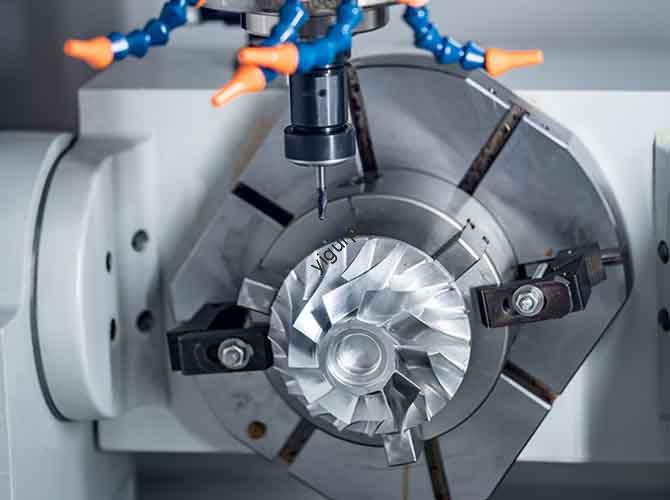Nel mondo manifatturiero frenetico di oggi, how do factories produce complex parts with consistent accuracy and efficiency? La risposta sta dentro lavorazione CNC automatica—una tecnologia che ha rivoluzionato il modo in cui creiamo componenti per le industrie, dall'aerospaziale ai dispositivi medici. Questa guida analizza tutto ciò che devi sapere su questo processo rivoluzionario, dalla sua struttura di base alle applicazioni nel mondo reale.
1. Che cos'è la lavorazione CNC automatica?
Al centro, lavorazione CNC automatica Utilizza il controllo numerico del computer (CNC) sistemi per automatizzare i movimenti delle macchine utensili, eliminando la necessità di una regolazione manuale costante. A differenza della tradizionale lavorazione manuale, che si affida all’abilità umana per guidare gli strumenti, La lavorazione CNC segue istruzioni preprogrammate per garantire risultati ripetibili, Risultati di alta qualità.
Componenti chiave di un sistema di lavorazione CNC automatico
The system cannot function without four critical parts. The table below outlines their roles:
| Componente | Primary Function |
| CNC Machine Tools | Execute physical machining tasks (PER ESEMPIO., taglio, perforazione, fresatura) on raw materials. |
| CNC Control System | Interpret program code and send signals to control tool speed, posizione, e velocità di alimentazione. |
| Programming Software | Create G-code (Il linguaggio delle macchine CNC) using 3D models (PER ESEMPIO., CAD software outputs). |
| Skilled Operators | Monitor operations, troubleshoot errors, and adjust parameters for optimal performance. |
2. 3 Vantaggi imbattibili della lavorazione CNC automatica
Why do manufacturers worldwide choose automatic CNC machining over traditional methods? Here are three non-negotiable benefits:
- Alta automazione: Una volta programmato, CNC machines can run 24/7 con un intervento umano minimo. Per esempio, a medical device factory can produce 500+ precision surgical screws in a single shift—something manual machining could never match.
- Precisione eccezionale: CNC systems operate with tolerances as tight as ±0.001 inches (0.0254 mm). This level of accuracy is critical for aerospace parts, where even a tiny error could lead to catastrophic failures.
- Strong Flexibility: Need to switch from making a aluminum bracket to a stainless steel gear? Simply update the program—no need to retool the entire machine. This cuts setup time by 50% or more compared to traditional machining.
3. Il processo di lavorazione CNC automatico passo dopo passo
Creating a part with automatic CNC machining follows a linear, flusso di lavoro ripetibile. Think of it like baking a cake: you need the right recipe (programma) and steps to get a consistent result.
- Design Modeling: Utilizzo Software CAD (PER ESEMPIO., Solidworks, AutoCAD) to build a 3D digital model of the part. This model acts as the “blueprint” for machining.
- Conversione dei dati: Export the CAD model to a format CNC machines understand, ad esempio Stl (Linguaggio standard per la maglietta) or STEP. This step ensures the machine can “read” the design.
- Affettare & Programmazione: Usa cam (Produzione assistita da computer) software to slice the 3D model into 2D layers (like slicing a loaf of bread). The software then generates G-code—specific instructions for the machine’s tools.
- Layer-by-Layer Machining: The CNC machine follows the G-code to remove material (PER ESEMPIO., via milling or turning) strato per strato, shaping the raw material into the desired part.
- Post-elaborazione: Finish the part with tasks like sanding (per lisce le superfici), sfacciato (to remove sharp edges), o dipingere (per resistenza alla corrosione).
4. Lavorazione CNC automatica vs. Macchina tradizionale: Un chiaro confronto
Is automatic CNC machining worth the investment? Let’s compare it to traditional manual machining using key metrics:
| Metrica | Automatic CNC Machining | La tradizionale lavorazione manuale |
| Precisione | Tolerances of ±0.001–±0.005 inches | Tolerances of ±0.01–±0.05 inches (Dipende dall'abilità dell'operatore) |
| Velocità di produzione | 2–5x faster for high-volume runs | Lento; limited by human reaction time |
| Labor Requirement | 1 operator can monitor 3–5 machines | 1 operator per machine |
| Costo per parti complesse | Inferiore (no retooling for design changes) | Più alto (requires custom tools for each part) |
5. La prospettiva di Yigu Technology sulla lavorazione CNC automatica
Alla tecnologia Yigu, vediamo lavorazione CNC automatica as the backbone of modern manufacturing innovation. Nell'ultimo decennio, Abbiamo aiutato 200+ clients—from automotive startups to medical device makers—adopt CNC solutions that cut production costs by 30% e migliorare la qualità della parte di 40%.
The biggest pain point we solve? Small-batch production inefficiencies. Many manufacturers worry CNC is only for large runs, but our tailored programs let clients produce 10–500 parts cost-effectively. Man mano che la tecnologia avanza (PER ESEMPIO., AI-powered CNC systems), we’ll keep making this tool more accessible to drive industry growth.
Domande frequenti: Risposte alle tue principali domande sulla lavorazione CNC automatica
Q1: Quali materiali possono essere utilizzati nella lavorazione CNC automatica?
A1: Almost any rigid material works, compreso l'alluminio, acciaio, titanio, plastica (PER ESEMPIO., Addominali), legna, and even some ceramics. The choice depends on the part’s use (PER ESEMPIO., Titanio per parti aerospaziali ad alta resistenza).
Q2: Quanto tempo è necessario per programmare una macchina CNC per una nuova parte?
A2: Per parti semplici (PER ESEMPIO., una fascia di base), programming takes 1–2 hours. Per parti complesse (PER ESEMPIO., a medical implant with curved surfaces), it may take 4–8 hours—still faster than creating custom tools for traditional machining.
Q3: La lavorazione CNC automatica è adatta alle piccole imprese?
A3: SÌ! Many CNC providers (Come la tecnologia Yigu) offer scalable solutions. Small businesses can start with a single machine and short-run programs, avoiding large upfront investments while still enjoying CNC’s accuracy and speed.
